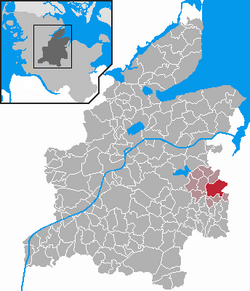Flintbek
| Flintbek | ||
|---|---|---|
|
||
| Coordinates: 54°15′N 10°4′E / 54.250°N 10.067°ECoordinates: 54°15′N 10°4′E / 54.250°N 10.067°E | ||
| Country | Germany | |
| State | Schleswig-Holstein | |
| District | Rendsburg-Eckernförde | |
| Municipal assoc. | Flintbek | |
| Government | ||
| • Mayor | Horst-Dieter Lorenzen | |
| Area | ||
| • Total | 17.57 km2 (6.78 sq mi) | |
| Elevation | 50 m (160 ft) | |
| Population (2015-12-31) | ||
| • Total | 7,305 | |
| • Density | 420/km2 (1,100/sq mi) | |
| Time zone | CET/CEST (UTC+1/+2) | |
| Postal codes | 24220 | |
| Dialling codes | 04347 | |
| Vehicle registration | RD | |
| Website | www.flintbek.de | |
Flintbek is a municipality in the district of Rendsburg-Eckernförde, in Schleswig-Holstein, Germany. It is situated at the Eider River, c. 10 km southwest of Kiel. The meaning of the name is controversial, but one possibility is the combination of flint(stone) with the word bek (beck, brook).
Flintbek is the seat of the Amt ("collective municipality") Flintbek.
Possible early evidence of wheeled transport has been found in conserved track trails in Flintbek dated ca. 3,600 BC.
The Lutheran Church dates back to at least 1223, when Earl Albrecht of Orlamünde, Governor of the Danish King, gave permission to the Monastery of St. Augustine to build a church in Flintbek. The present building is late gothic with an impressive wooden tower and steeple. The interior has a carved wooden "Schnitzaltar".
In the church cemetery is a 1952 sculpture by Friedrich Wilhelm Klose, Mutter des Ostens (Mother of the East). She represents the suffering and misfortunes of those driven from their homes due to war. The inscription reads:
„Ich will euch trösten, wie einen seine Mutter tröstet. Jes. 66,13. Wir gedenken unserer teuren Toten in der ostdeutschen Heimat.“
"I will comfort you as one whom his mother comforts. Isa. 66.13. We pray for our beloved dead in the East German homeland. "
Also in the cemetery is a memorial to the dead of both World Wars.
Pleasant walks along the river Eider are readily available. The oldest iron bridge in Germany (1865) is in the Eider Valley, in the adjacent community of Techelsdorf.
...
Wikipedia



